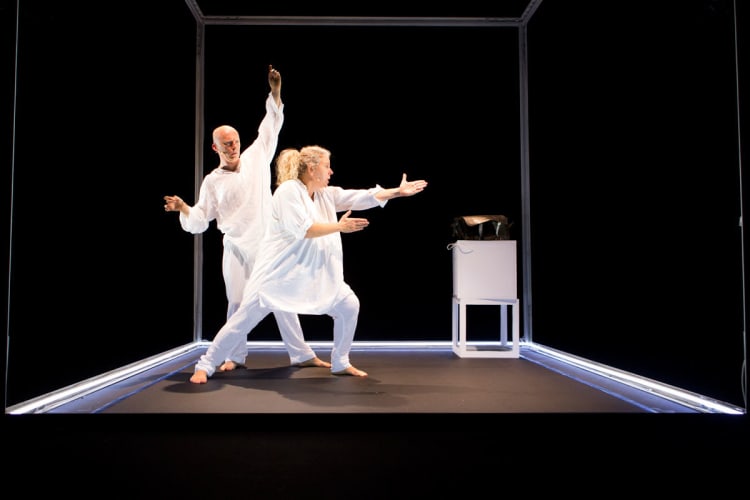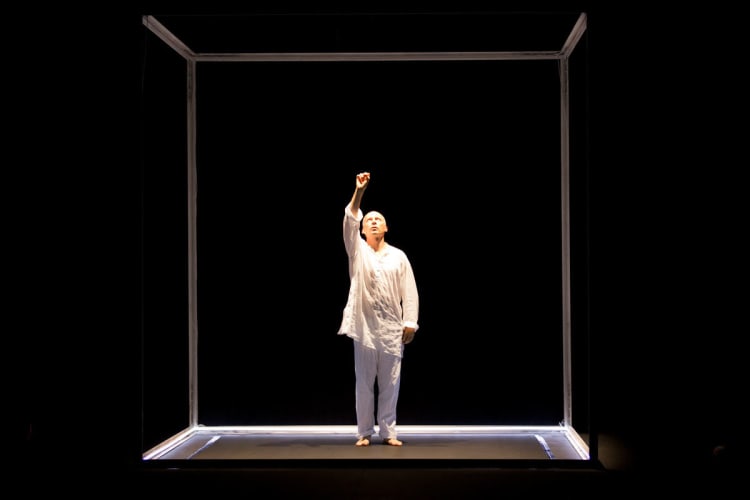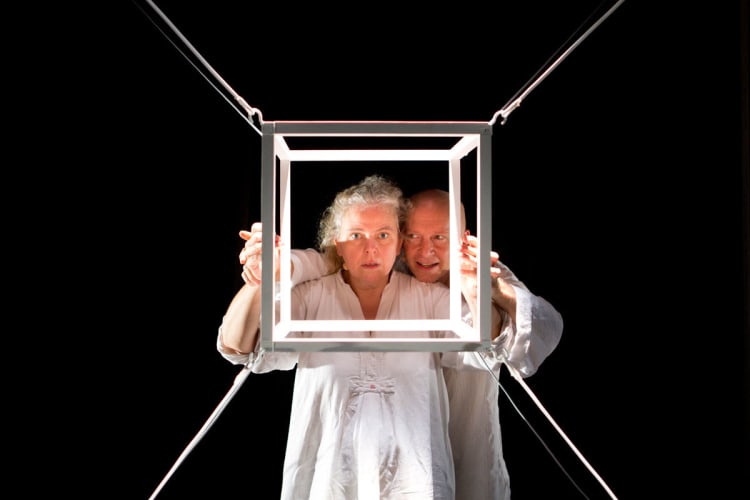I is a strange loop captures vividly the push and pull between physicality and the abstract world of numbers in a flow of mathematical speak rubbing up alongside a debate on the consciousness of life, death and mortality.
A lot to digest in 100 minutes, especially if you are neither maths whiz nor science geek, but when the abstract and physical worlds clash in the form of two actors floating about in white Grecian garb posing as X and Y, the effects are funny, illuminating and often baffling.
Tonight’s piece, part of a triptych created for the Barbican’s Life Rewired season, tackles what it means to be human at a time when advances in technology and scientific research are hurtling forward with unprecedented speed.
It’s also the brainchild of the creative duo behind Complicite’s A Disappearing Number, illuminating the life of maths genius Srinivasa Ramanujan, so the bar is set high.
Action opens on Marcus du Sautoy, otherwise known as X, all alone in a glowing fluorescent cube espousing the beauty of an infinite universe and abstract thought. He defines the cube through movement and there are genuine capsules of thoughtfulness in his performance whilst he inhabits the space in solitary practice.
Soon on in, Victoria Gould, or Y, rocks up to blast apart the meditative atmosphere, huffing and puffing, laden with her sensorial suitcase full of physical challenges and solid objects to take on X’s abstract, infinite world.
Gould slices her way into the cube and sits down with grounded forcefulness of the mother ship from planet Earth, feet firmly planted, taking out a green knife from her white bag to unpeel an orange.
This is no average orange plucked from a fruit bowl. This orange is so bright and luscious, bursting with curved sensuality in comparison to the geometric emptiness of the surrounds. Upon offering an orange to X, the audience can picture the deliciousness of the juice sliding down X’s throat in unadulterated pleasure as he bites through each segment.
Y is there to physically interact with X and thus challenge every belief that X delivers through his continuous sequence of complex mathematical equations. Gould is ready for the fight and is brilliantly physically present. Drawing on her physical theatre background with Complicite and an MSc in maths, she is formidable as Y, then melts into something funny when she transforms back into Victoria.
Gould is engagingly direct and infuses genuine warmth into her character in the pursuit of knowledge, a bit like an interested neighbour bringing round a cake for tea and gossip.
De Sautoy, meanwhile, is no lightweight, floating around in white, loose trousers practicing a cross between Laban and Tai-Chi inspired movements in his cube. He is Simonyi Professor for the Public Understanding of Science at Oxford and this stuff actually means something to him, unlike some of us in the audience.
As the interaction between X and Y develops, there’s an argument about infinity and trying to escape the pattern of life and death by “ getting out” until eventually the unlikely duo form a “strange loop.” According to De Sautoy, inspired by the writings of Douglas Hofstadter and his cult book, Godel, Escher, Bach, a strange loop is a cyclical structure that goes through several layers of a hierarchical system to find itself back at the beginning.
Complicated and impressive but what’s the result theatrically? There may be only one strange loop that’s curved around the stage using a ball of string, but there are multiple ideas to grapple with in a short space of time all jostling for attention. The only problem is that one idea cancels out the other, often loosing sight of the overall intention of the piece.
There’s also a nagging sensation of not being quite smart enough to follow what’s happening. Or perhaps that’s just me.The advantage of this onslaught of complex academic theories is that if maths isn’t a favourite subject, there are entry points through other philosophical musings from questioning mortality and consciousness to the concept of time and how all of this will one day differentiate between humans and the formation of consciousness in artificial life.
The drama becomes less intriguing when the plot veers into farce and the actors become themselves, not X and Y. This somehow shatters the mysterious, fun illusion that while we are watching humans, its easy to imagine actors as algorithms and something other than flesh and blood.
AI’s ability to replicate human consciousness remains to be seen, but tonight clearly asks lots of questions without giving the answers away. While there’s much originality at the heart of I is a strange loop, there’s also confusion in terms of how to absorb this textual overload of information. It's worth giving it a chance though as it's highly inventive and leaves more than a trace of interest as night turns to day.


